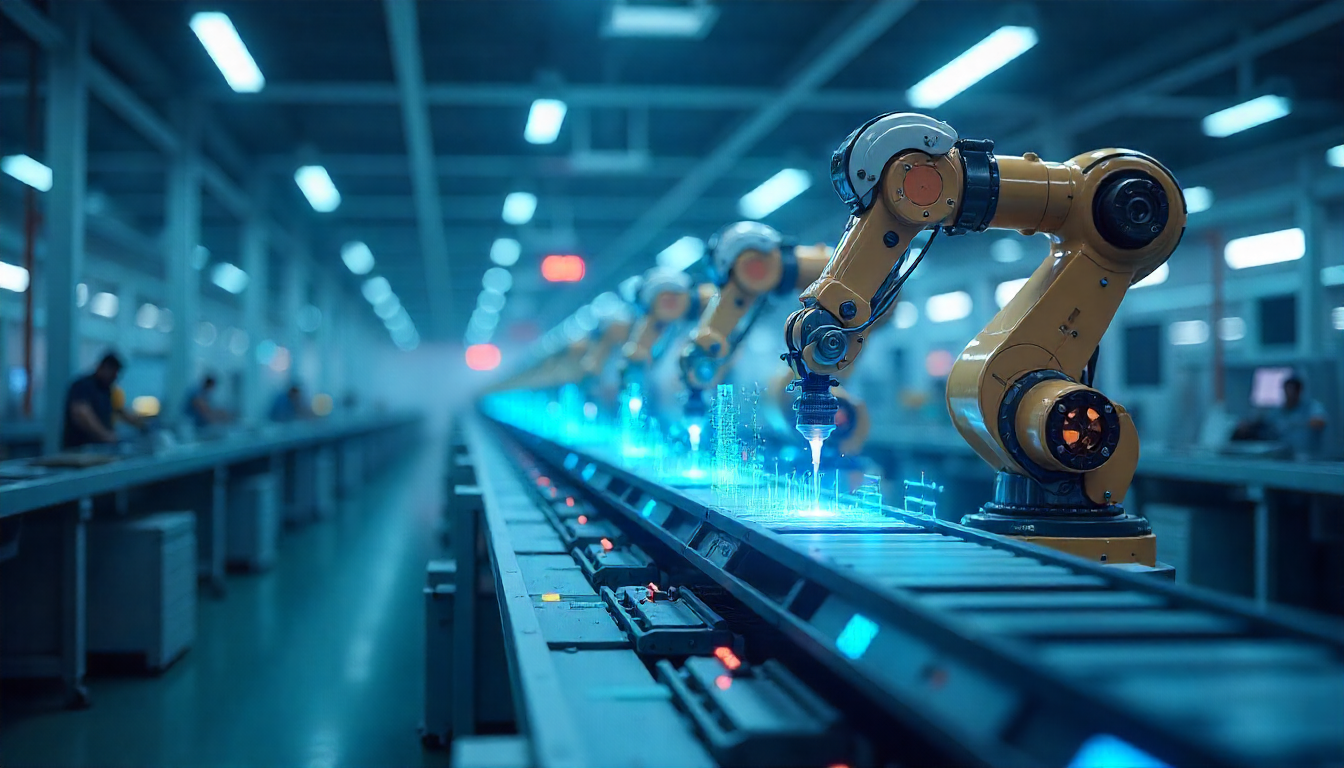The manufacturing and warehouse landscape is evolving rapidly. Rising labor costs, mounting quality demands, and fierce global competition mean standing still isn’t an option. Today’s leaders are adopting intelligent automation—combining IoT sensors, AI-powered systems, and robotics—to eliminate bottlenecks, reduce costs, and scale operations. This guide explores the technologies driving transformation and shows how leading organizations are achieving measurable ROI.
The Manufacturing Crisis: Why Change Is Urgent
Manufacturing facilities face interconnected challenges that traditional approaches cannot solve. Downtime costs average $125,000 per hour. Manual inspection processes introduce 3-6% rework rates. Labor shortages force lines to operate at 80% capacity. Equipment failures cascade through supply chains, disrupting customer commitments.
These aren’t rare scenarios—they’re systemic vulnerabilities affecting most traditional facilities. The Industrial Internet of Things (IIoT) market is projected to reach $400 billion by 2026, driven by manufacturers recognizing that automation isn’t optional—it’s essential for competitive survival.
Companies implementing automation report staggering returns: 70-75% reduction in equipment breakdowns, ROI exceeding 250% within 18-24 months, and production capacity increases of 20- 50%. The competitive gap widens daily between automated and manual operations.
Core Technologies Transforming Manufacturing
Real-Time Monitoring Through IoT Sensors
Smart manufacturing begins with visibility. IoT sensors deployed across production lines continuously monitor temperature, vibration, pressure, energy consumption, and equipment performance. This data flows to centralized dashboards, enabling instant detection of anomalies before they escalate into costly failures.
Real-time monitoring reduces equipment breakdowns by 70% and cuts maintenance costs by 25%. Organizations gain unprecedented visibility into production efficiency—from individual machine components to entire supply chain logistics.
Want to see IoT in action? → Read how Aegus automated solar maintenance with IoT sensors
Predictive Maintenance: Stop Problems Before They Start
Traditional reactive maintenance waits for failures. Preventive maintenance follows fixed schedules regardless of actual equipment condition. Predictive maintenance uses IoT sensors and AI algorithms to forecast failures days or weeks in advance.
The results are dramatic: 70-75% fewer breakdowns, 35-45% reduced downtime, 10x ROI potential, and equipment lifespan extensions of 20-30%. The U.S. Department of Energy reports 95% of companies achieve positive returns, with 27% recovering full investment within 12 months.
Real-world example: Ford’s commercial division saved 122,000 hours of downtime and $7 million
on a single component by predicting 22% of failures 10 days early.
AI-Powered Vision Systems: Inspection at Machine Speed
Computer vision systems equipped with industrial cameras and deep learning algorithms inspect products at speeds impossible for humans—while achieving superior accuracy. These systems detect sub-millimeter defects, identify misalignments, count objects with 100% precision, and validate specifications in real-time.
Vision automation eliminates inspection bottlenecks, reduces rework by up to 97%, and ensures consistent quality. Integration with Programmable Logic Controllers (PLCs) enables automatic corrective action, stopping production before defects propagate downstream.
See it in practice → Discover how Primacy eliminated manual inspection errors
Autonomous Mobile Robots (AMRs) and Automated Guided Vehicles (AGVs)
Warehouse automation through AMRs and AGVs transforms material handling with measurable benefits:
Labor optimization: Robots automate repetitive tasks 24/7, freeing ~166 labor hours daily and eliminating overtime
Efficiency gains: Optimized routing and continuous operation reduce cycle times by 40-70%
Space utilization: Narrow-aisle navigation and vertical integration maximize warehouse capacity
Inventory accuracy: Real-time tracking via Warehouse Management Systems keeps records current
Safety enhancement: Collision avoidance and automated hazardous task handling reduce incidents
Energy efficiency: Rechargeable batteries and optimized consumption reduce long-term costs
AGV automation delivers 95% labor reallocation with 18-24 month ROI, while AMR solutions
achieve 12-18 month ROI with greater workflow flexibility.
Industry 4.0: The Connected Ecosystem
Industry 4.0 represents full convergence of IoT, AI, robotics, cloud computing, and data analytics. Smart factories leverage:
Smart connectivity: Seamless device-to-device and system-to-system communication
Real-time analytics: Actionable insights into inventory, equipment performance, and supply chain trends
Advanced robotics: Precision handling of repetitive tasks with minimal human intervention
Autonomous decision-making: AI systems optimize parameters without human oversight
Digital twins: Virtual models simulate operational changes before physical implementation
Predictive analytics: ML algorithms forecast demand, maintenance needs, and supply chain disruptions
Warehouses implementing Industry 4.0 technologies are projected to grow at 7.1% CAGR through 2030, driven by labor shortages, rising costs, increasing complexity, and demand for faster fulfillment.
Real-World Impact: Case Studies Demonstrating Results
Case Study 1: Primacy Industries – Vision Automation for Zero-Defect Production
The Problem:
Primacy’s wax-filling line relied on two dedicated QC personnel per shift to manually count candles and verify alignment before molten wax was dispensed. Misalignments caused spilled wax, damaged wicks, and costly rework. The inspection process became the production bottleneck, limiting capacity to 80% of target.
The Solution:
Primacy deployed an AI-powered vision automation system with high-precision industrial cameras and a proprietary deep learning model. The system performs real-time counting with ±0.5mm alignment validation and automatically stops the wax dispenser if faults are detected.
The Results:
| Metric | Before | After | Improvement |
| Inspection Accuracy | ~95% | 100% | Error Elimination |
| Inspection Time | 15 sec/tray | <4.5 sec/tray | 70% Reduction |
| Rework/Scrap Rate | 3.2% | <0.1% | 97% Reduction |
| QC Labor | 2 operators/shift | 0 operators/shift | 100% Reallocation |
Business Impact: Production capacity increased 25% while achieving premium quality. The freed QC personnel were cross-trained for higher-value roles, and near-zero scrap rates significantly improved profit margins.
Next Phase: Primacy is integrating collaborative robots (cobots) guided by the vision system to automatically correct misaligned containers—advancing toward fully autonomous production.
→ Read the Full Primacy Case Study for detailed technical implementation and roadmap
Case Study 2: Aegus – IoT-Powered Autonomous Solar Maintenance
The Problem:
Aegus’s solar panel cleaning systems required manual operation at dangerous heights with continuous human supervision. Inconsistent cleaning caused 4-6% energy yield losses. High labor requirements made scaling to utility-scale projects economically unviable.
The Solution:
SunBio IT developed a Smart IoT-based autonomous cleaning system integrating LiDAR/ultrasonic sensors, real-time cloud telemetry, remote scheduling, and advanced battery management.
Technicians now manage entire solar farm cleaning cycles remotely from desktop or mobile devices.
The Results:
| Metric | Before | After | Improvement |
| Safety Incidents | Moderate Risk | Zero Risk | 100% Elimination |
| Cleaning Cycle Time | 8 hours | 4 hours | 50% Reduction |
| Operational Labor | 2 supervisors/site | 0.1 remote operator/site | 95% Reallocation |
| Energy Yield Loss | 4-6% | <1% | 5-7% Improvement |
Business Impact: Aegus achieved unprecedented safety records while maximizing panel efficiency and energy output. The system enables management of significantly larger asset portfolios with
minimal personnel, enabling rapid, profitable expansion into utility-scale maintenance.
Next Phase: Machine learning will analyze sensor data to autonomously determine optimal cleaning frequency and paths, while future SCADA integration will provide holistic asset performance management.
→ Read the Full Aegus Case Study for technical architecture and implementation timeline
Case Study 3: AI-Powered Research Automation – Scientific Precision at Scale
The Problem:
In regulated R&D environments, manual tracking of Structured Resource Identifiers (SRIDs) and Research Resource Identifiers (RRIDs) diverted researchers from experimental work. Manual transcription errors created traceability risks and compliance concerns.
The Solution:
We developed an AI-driven computer vision platform with specialized ML models for SRID detection and RRID validation. The system analyzes laboratory images, automatically extracts identifiers, and cross-references scientific databases for real-time compliance checking.
Business Impact: The automation revolutionized resource management workflows, reclaiming researcher time for core experimental work while eliminating transcription errors and automating compliance reporting.
→ Read the Full Research Automation Case Study for implementation details
ROI Reality: Calculating Automation Returns
Smart automation delivers returns across multiple dimensions:
Direct Cost Savings:
Labor cost reduction: 30-95% depending on application
Maintenance cost reduction: 25-30% via predictive approaches
Energy savings: 10-20% through optimization
Material waste reduction: 70-97% via precision processes
Productivity Gains:
Production capacity: +20-50%
Downtime reduction: -30-75%
Cycle time reduction: -40-70%
Quality: Near-zero defect rates achievable
Example: Predictive Maintenance ROI Initial Investment: $285,000
System: $200,000 | Implementation: $50,000 | Training: $20,000 | Annual maintenance: $15,000
Annual Value Generated: $1,606,000
Downtime reduction: $1,200,000 | Labor savings: $36,000 | Equipment lifespan extension:
$60,000 | Energy efficiency: $10,000 | Capacity gains: $300,000
Result: 564% first-year ROI
Most automation projects achieve positive ROI within 6-18 months, with compounding benefits as systems optimize over time.
Implementation Challenges & Solutions
Challenge 1: High Initial Capital Investment
Solution: Adopt flexible “Automation-as-a-Service” models shifting CapEx to OpEx. Begin with 6- week proof-of-concept pilots targeting high-impact bottlenecks. Demonstrate rapid ROI before scaling. Many providers offer financing solutions with predictable monthly payments.
Challenge 2: Legacy System Integration
Solution: Deploy middleware and IoT gateways enabling legacy equipment to communicate with modern platforms. Implement modular automation integrating incrementally without complete system replacement. Partner with experienced systems integrators bridging old and new architectures.
Challenge 3: Workforce Transition
Solution: Position automation as workforce augmentation, not replacement. Robots handle repetitive tasks while humans focus on high-value roles requiring judgment and creativity. Invest in upskilling programs transforming operators into automation technicians and data analysts.
Challenge 4: Data Management & Cybersecurity
Solution: Implement robust data governance, edge computing for sensitive processing, and defense- in-depth cybersecurity. Ensure encryption, access controls, and regular security audits aligned with industry standards.
What to Expect: The Future of Manufacturing
The automation landscape is rapidly evolving toward:
Autonomous decision-making: AI systems optimizing production without human intervention
Collaborative robotics: Humans and cobots working safely in shared workspaces (proven 85% more productive than either alone)
Edge AI processing: Real-time device-level decision-making reducing latency and bandwidth
Enhanced supply chain visibility: RFID and IoT tracking providing real-time material and product location
Digital twins and cyber-physical systems: Virtual models predicting operational effects before physical implementation
Around 42% of warehouses and distribution centers are planning additional AI investment, with growth projected at 7.1% CAGR through 2030.
Taking Action: Your Automation Roadmap
The question isn’t whether to automate—it’s whether you’ll lead or follow the transformation. Here’s how to start:
Phase 1: Assessment (Weeks 1-2)
Identify highest-impact bottlenecks (longest downtime, highest scrap rates, most labor-intensive processes)
Analyze current state and quantify opportunity (potential ROI, payback period)
Define success metrics
Phase 2: Pilot (Weeks 3-8)
Implement proof-of-concept on single process or line
Measure baseline vs. automated performance
Build internal expertise and organizational confidence
Phase 3: Scaling (Months 3+)
Expand to additional production lines or warehouse areas
Optimize systems based on pilot learnings
Continue adding automation layers (AMRs, predictive maintenance, etc.)
About SunBio IT Solutions
SunBio IT Solutions specializes in Industry 4.0 automation, IoT integration, and AI/ML solutions for manufacturing, agriculture, pharmaceuticals, and industrial sectors. Since 2012, we’ve delivered end- to-end digital transformation—from smart sensors to cloud analytics—helping organizations enhance efficiency, ensure compliance, and drive sustainable growth.
Our Capabilities:
Custom IoT sensor integration for real-time production monitoring
AI/ML solutions for predictive maintenance and computer vision
Robotic automation for material handling and precision assembly
Cloud-based analytics platforms delivering actionable insights
Compliance-ready systems meeting GLP, 21 CFR, and HIPAA standards
Our Approach:
Pilot-first methodology validating ROI before scaling
End-to-end integration from PCB design to cloud platforms
Industry-specific expertise combined with deep technical knowledge
Continuous optimization ensuring sustained performance gains
Global Presence: India, Botswana, France, UAE, and the US
Ready to transform your operations? Contact SunBio IT Solutions today for a customized automation assessment.
Contact us: www.sunbioit.com/Connect.html

